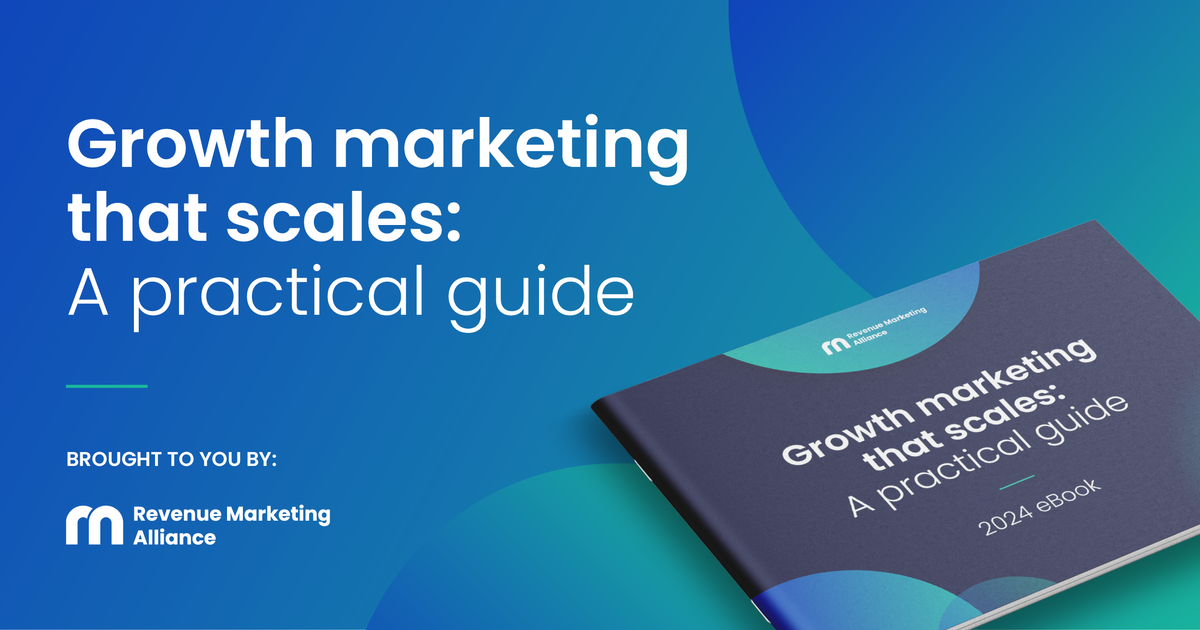Pop quiz: What's the not-so-secret weapon of fast-growing companies?
If you said “a great product” or “unlimited marketing budget,” you're only half right.
The real answer? Growth strategies that actually deliver.
Now, before you roll your eyes and mutter “easier said than done,” hear us out. We know resources are tight – just ask the 47.1% of revenue marketers who ranked it as their top challenge in the 2023 State of Revenue Marketing report. But here's the thing: with the right strategies, you can turn those lemons into some seriously profitable lemonade.
Ready to join the big leagues? Strap in, because we're about to take you on a whirlwind tour of five growth strategies that could revolutionize your business.
From cracking the code of product-market fit to building a customer acquisition funnel that practically fills itself, we've got you covered. And just when you think it can't get any better, we'll show you how to create a customer experience so amazing, it'll make your competition weep.
Let's dive in, shall we?
Strategy 1: Nailing product-market fit
As Marc Andreessen famously said:
"Product-market fit is the only thing that matters."
In other words, you can have the slickest marketing campaigns, the most irresistible offers, and a sales team that could sell umbrellas in a drought, but if your product isn’t hitting the mark with your target audience, it’s all for nothing.
So, what exactly is product-market fit? There are a lot of definitions out there, but simply put, it’s the magic moment when your product perfectly matches the needs of your market.
For a sobering reminder of just how important this is, look no further than CB Insights’s study, The Top 20 Reasons Startups Fail. The number-one reason? Failing to serve a market need.
On the other side of the coin, when you achieve product-market fit, not only do your sales skyrocket, but there’s a multiplying effect as happy customers spread the word. Thanks to this word-of-mouth marketing, customer acquisition costs (CAC) plummet – after all, happy customers are the best (and cheapest) marketing channel.
PMF also sets the stage for scaling your business. Knowing you have a product that the market is hungry for, you can confidently invest in growth strategies – plus, investors and top talent are more likely to come knocking at your door.
How to nail your product-market fit
To achieve PMF, you need to start by understanding your market and customers. That means conducting market research, engaging directly with your audience, and developing detailed customer personas. This is the key to zeroing in on the problem that your product can solve better than anything else out there.
Next, roll out a minimum viable product (MVP). Forget the bells and whistles and focus on the core features that address your target audience’s pain points. Launch it to a small, controlled audience, pay close attention to how they’re using it, and gather feedback.
Are they coming back for more? Are they telling their friends about it? If not, you might need to make a few tweaks.
Finally, once you’ve got a good thing going, it’s time to start scaling. Broaden your market, invest in marketing, and optimize your pricing strategy to reflect the value you’re providing. But don’t get too comfortable – markets change, and so do customer needs. It’s important to keep monitoring key metrics and be ready to adapt to changing customer demands.

Strategy 2: Optimizing customer acquisition funnels
Your customer acquisition funnel is the backbone of your business growth. If it’s not optimized, you’re missing out on serious revenue.
The funnel is the journey your potential customers take, from the first time they hear about you to the moment they become loyal fans. The smoother and more efficient you make that journey, the more customers you’ll convert and the less you’ll spend on making that happen.
How to optimize your funnel
According to the 2023 State of Revenue Marketing report, optimizing the funnel is a priority for 32% of revenue marketers. So, let’s dive into how you can do just that.
First, take a good hard look at your funnel and identify any weak spots.
Where are potential customers dropping off? Is it your landing page? Your sign-up process? You’ll need to hone in on these friction points and fix them. This might mean simplifying your forms, making your calls-to-action (CTAs) more compelling, or ensuring your site loads faster than a caffeine-fueled cheetah.
Next, personalize the journey. Tailoring the experience based on user behavior, preferences, or demographics can work wonders for your conversion rates. Think about it – who doesn’t love a little personal touch? Whether it’s personalized content, offers, or product recommendations, making your customers feel seen and understood will keep them moving through the funnel.
Don’t forget to A/B test everything. Your headlines, CTAs, images – test them all. Even small tweaks can lead to big wins. The key here is to keep testing and refining until you find what works best for your audience.
Once you’ve optimized the top of the funnel, shift your focus to the middle and bottom. This is where lead nurturing and retention come into play. Use email sequences, retargeting ads, and onboarding processes that keep your customers engaged and coming back for more.
Strategy 3: Building a referral engine
If there’s one growth strategy that doesn’t get enough credit, it’s the referral engine. Customer referrals work wonders because people trust recommendations from people they know. It’s as simple as that.
As award-winning growth and demand generation marketing leader Nick Mamouzellos puts it:
“The network effect is real and more powerful than ever. Executing a growth strategy using tactics for referrals and influencer marketing is what takes you from 1 = 1 to 1 +1 = 3.”
When done right, a referral program can turn your satisfied customers into a motivated sales force, bringing in high-quality leads that are primed to convert.
And here’s the best part: referrals are incredibly cost-effective. This is a vital consideration in a world where over 50% of revenue marketers experienced budget cuts last year and more than 40% view the lack of marketing budget as the biggest barrier to meeting their revenue goals and growing as a company.
You’re not spending a fortune on marketing campaigns. Instead, you’re rewarding your customers for doing what they’d probably do anyway – talking about a product they love. This means lower customer acquisition costs and a steady stream of organic growth.

How to build your referral engine
First things first, you need to make it easy – ridiculously easy – for your customers to refer others. This could be as simple as adding a “tell a friend” button to your website or app. The less effort it takes for someone to spread the good word about your product, the more likely they are to do it.
Next, offer rewards that matter. Think beyond discounts and offer something your customers really want – maybe it’s exclusive access to new features, a free upgrade, or even cold, hard cash.
That old “If you build it, they will come” chestnut doesn’t apply here, so don’t forget to promote your referral program. You can make sure your customers know about the program through email campaigns, social media, and even during the checkout process. A little reminder can go a long way in driving referrals.
Lastly, track your results and optimize as you go. Use analytics to see what’s working and what’s not. Are certain customers referring more than others? Is one type of reward driving more referrals? Use this data to refine your referral engine, making it even more effective over time.
Strategy 4: Using owned marketing channels
Let’s talk about something that should be music to every marketer’s ears: owned marketing channels.
These are the platforms you control – your website, blog, newsletters, and social media profiles. The beauty of owned channels? They give you a direct line to your audience with zero gatekeepers and minimal costs. If you’re not making the most of these channels, you’re leaving growth potential on the table.
Owned channels are the ultimate low-cost, high-return marketing tools. You’re not paying for clicks, impressions, or eyeballs – once you’ve built your audience, every interaction is essentially free.
This means your return on investment (ROI) is through the roof compared to paid advertising. Plus, you get to control the message entirely. No algorithms to outsmart, no ad placements to worry about – just pure, unfiltered communication with your audience.
Owned channels also allow for consistent, regular engagement. By delivering content directly to your customers’ inboxes or through your blog, you keep your brand top-of-mind. Plus, regular communication fosters trust, which is the foundation of customer loyalty and repeat business.

How to leverage owned channels effectively
First up, you need to maximize the content you’re putting out there. High-quality, relevant content is the key to driving engagement and building a loyal community.
Whether it’s insightful blog posts, valuable email newsletters, or engaging social media updates, your content should provide real value to your audience. Don’t just talk at them – start a conversation, answer their questions, and solve their problems.
Personalization is your best friend here. Use all the data you can get your hands on – everything from customer behavior to preferences to purchase history – and tailor your content. Segment your email lists, customize your blog recommendations, and personalize your social media interactions.
When your audience feels like you “get” them, they’re far more likely to engage with your content and, ultimately, your products or services.
Next, focus on building a community around your brand. Owned channels give you the perfect platform to foster relationships with your audience. Respond to comments on your blog, engage with followers on social media, and use your email list to keep the conversation going.
Lastly, don’t forget to keep an eye on the data. Owned channels offer a wealth of analytics that can help you understand what’s resonating with your audience and what’s falling flat. Use this data to make your content strategy more targeted and effective over time.
Strategy 5: Delivering an amazing customer experience
In a world where your competitors are just a click away, how you make your customers feel can be the difference between a one-time sale and a lifelong relationship. That’s why delivering an amazing customer experience (CX) isn’t just a nice-to-have; it’s a must-have if you want to see real growth.
When customers feel valued, understood, and delighted, they don’t just stick around – they tell their friends, rave about you on social media, and come back for more. You can’t buy this kind of word-of-mouth marketing, but you can earn with a killer CX strategy.
Plus, let’s not forget that a great experience smooths the path to conversion. When your customers enjoy every step of their journey – from discovery to purchase – they’re far more likely to complete that purchase and come back for more.
As if that wasn’t enough to convince you that a stellar customer experience is worth investing in, Rachel Rapoza, Presales Solutions Consultant at UKG, points out a benefit for your business that you simple can’t afford to ignore:
“If you have a top-tier customer experience, you can charge a premium for your product. [...]
“The important caveat here is that your experience needs to be materially differentiated. So you can't just say you have a great experience and sell at a premium and expect customers to hang around or be happy with their experience when they find out that's not quite the case.”
How to deliver an amazing customer experience
The beauty of this growth strategy is that it ties all the other strategies together.
Nailing product-market fit ensures you’re offering something your customers truly want. Optimizing your customer acquisition funnels removes friction, making it easier for them to buy from you. Implementing a referral engine taps into the power of community, while leveraging owned channels keeps the conversation going long after the initial purchase.

So, how do you take your CX from good to unforgettable? Start by listening to your customers. Gather feedback at every touchpoint – whether that’s through in-app surveys, social media, or direct interactions. This feedback is pure gold; use it to refine your processes, products, and services. Your customers will tell you what they need – it’s your job to deliver.
Next, focus on consistency. A seamless experience across all channels and touchpoints is crucial. Whether your customers are interacting with you online, in-store, or over the phone, they should receive the same high level of service and care. This builds trust and makes your brand reliable and predictable – in a good way.
Finally, don’t underestimate the power of the human touch. Personalization, thoughtful follow-ups, and going the extra mile can turn a mundane interaction into a memorable one. These small acts show your customers that you see them as individuals, not just accounts, and that’s what turns customers into lifelong fans.
Key takeaways
Let's take a moment to recap what we've learned. Think of these takeaways as your cheat sheet for world domination (or at least some serious business growth):
🧩 Nail product-market fit: Make sure your product perfectly meets your market’s needs to create a strong foundation for growth.
🛠 Optimize your customer acquisition funnel: Smooth out every step of the customer journey to boost conversions and reduce costs.
👥 Build a referral engine: Leverage the power of word-of-mouth marketing to drive organic growth without breaking the bank.
📢 Leverage owned marketing channels: Engage your audience on the platforms you control for cost-effective and consistent communication.
💖 Deliver an amazing customer experience: Go above and beyond to delight your customers and turn them into brand advocates.
💰 Shrinking budget? Don’t sweat it: Smart strategies can help you overcome resource limitations.
Ready for scalable, repeatable growth? Then our playbook is for you.
This doc lifts the veil on what's behind exponential revenue growth by helping you to develop a strong strategy, optimize your marketing funnel, create tailored customer content, and more.




 Follow us on LinkedIn
Follow us on LinkedIn



